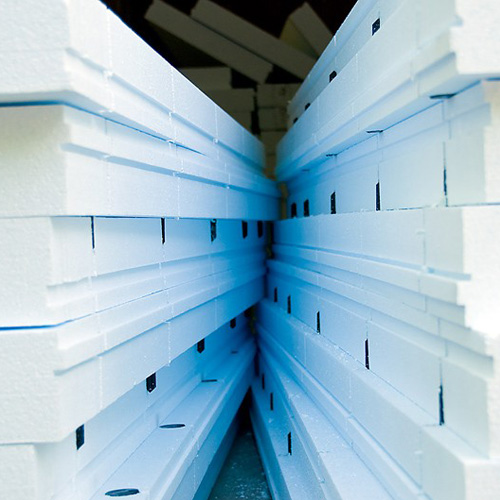Extruded Insulation
Extruded Polystyrene insulation is one of the two main insulation materials used in the manufacturing process for walk-in coolers and freezers. Extruded polystyrene insulation is a closed-cell insulation structure with resistance to moisture absorption. These characteristics, along with it’s strength, are what make Extruded Polystyrene the optimal choice for the cold storage industry.

Specifications
Extruded Polystyrene’s closed-cell structure and lack of voids results in a higher, longer-lasting R-value. Extruded Polystyrene holds its R-value longer than other insulation types. While other insulation types only retain 25% of their R-value within 5 years, Extruded Polystyrene retains 75% of it’s R-value over the same period.
The continual objective of the insulation in walk-ins is to maintain a high R-value which ultimately saves energy. Obtaining and maintaining the highest possible R-value is the key to achieving the highest energy efficiency over the life of the unit. Extruded Polystyrene meets and exceeds the requirements for the Energy Independence and Security Act of 2007 and upcoming federal regulations.
One of the largest factor’s that can affect the insulation’s performance is moisture. When water starts collecting inside walk-in insulation, the R-value drops and moisture inside the insulation starts to freeze. When there are extreme environmental differences in the temperature on the inside and the outside of the walk-in, the insulation is vulnerable to retaining moisture in the structural voids. As water has a much lower R-value than insulation, the water reduces the R-value of the insulation. As the R-value decreases, the unit’s refrigeration system has to work harder to hold the correct interior temperatures.
All wall and ceiling insulation is 4″ thick, high quality, rigid extruded polystyrene, 1.6 lb density. For coolers, the R-factor will be at least 7 .2 per inch making the R-value of the panels equal or greater than R-28.8. For freezers, the R-factor will be at least 8 per inch making the R-value equal or greater than R-32. Vapor transmission shall be less than 1 perm and foam core material must meet Owens Corning – UL Foam Core 5 flame spread rating with the average smoke rating of less than 175. (UL 723) Dow – UL Foam Core 15 flame spread rating with the average smoke rating of less than 165. (UL 723).
Each panel consists of inner and outer metal skins, a 4″ insulation core, and is equipped with cam-action locking devices. All panels connect to one another by placing the tongue of the insulation core of one panel into the groove of the core insulation of the adjacent panel. The resultant tongue and groove joint is sealed at both sides by double barreled gaskets. To avoid future swelling and mold formation, no wood is permitted in the manufacture of the tongue and groove panel profile.
